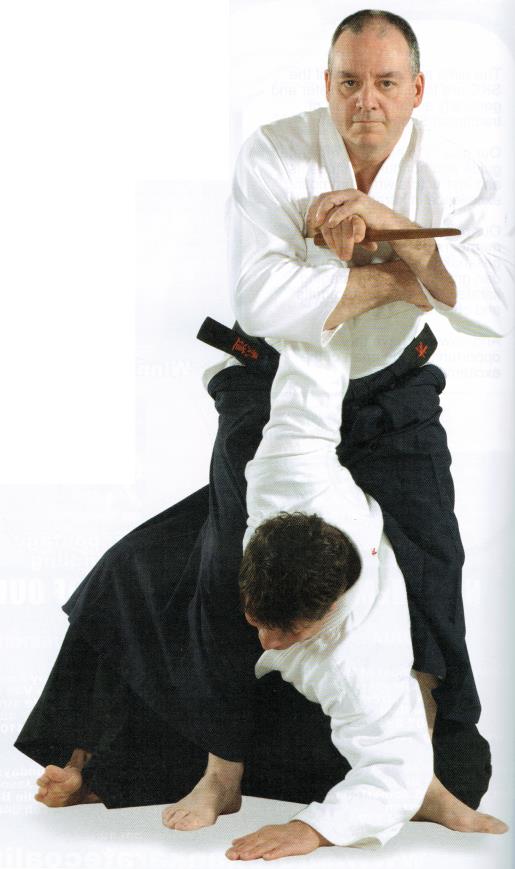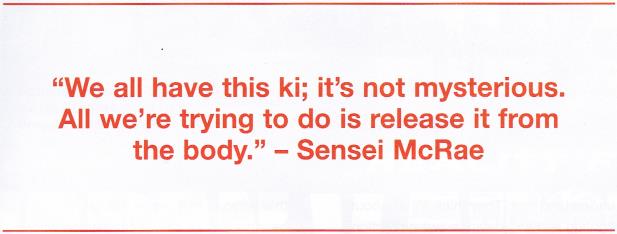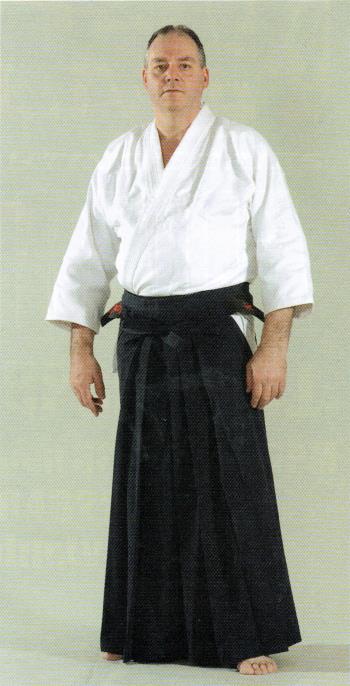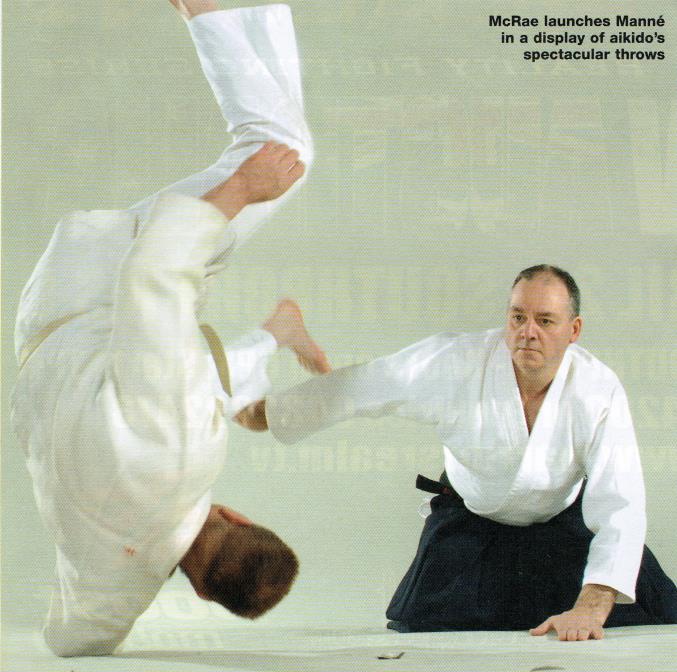
When it comes to the somewhat mysterious method of controlling opponents through their ki, or internal energy, Malcolm McRae is considered at the top of the game by some of Australia’s most experienced martial artists. These include Kyoshi Bob Jones, former bodyguard and founder of Zen Do Kai and the BJMA – one of the country’s largest martial arts organisations. Following on from our story No-Bull Aikido in the February issue of Blitz, here we present a selection of quotes from our interview with Sensei McRae, looking at the philosophies and theories behind the art he calls ‘ki fusion’.
McRae on ki fusion…
“[Sensei] David Brown gave me the idea to be able to separate the mind from the body when an attack is coming. I fuse my ki with the ki of the person’s attack coming in; I separate their spirit or intention from their physical body. Essentially, the further apart you can separate it, the easier it is to deal with their physical being. In the attack itself, we’re leading, because we lead their spirit — their physical body then comes along for the ride.
“If you’re dealing with a person who’s very strong, there is a cut-off point, of course, but what happens is you can deal with people who are physically stronger a lot more successfully. This means it can take me beyond my older age and where I think my physical power would be limited.
“It’s not about developing the ki; ki already exists. You can’t develop ki, but you can develop ibuki, which is breath, and you can develop techniques and better those too, but ki itself can’t be developed. We all have this ki; it’s not mysterious. All we’re trying to do is to release it from the body so that while the body’s in a more relaxed form, ki flows unrestricted around and out of the body, and it doesn’t conflict with the [other] person’s physical being, like our physical self does.”
On teaching ki fusion…
“I don’t really try to teach aikido to people from other martial arts. I don’t try to teach the Bob Jones guys that ‘aikido is amazing’; what I try to do is to enhance their understanding in their own art using aikido, and that’s what they come to me for. Everyone will be different, but all I know is that I’m dedicated in showing people how to unlock this inner power that we all have.
“The way I teach ki fusion to people, they’re able to learn it quite successfully. It does take time, but they will get it. The way we train aikido is quite unique — there’s no opponent, just a partner. One is the receiver and one is the attacker — not an attacker like in kickboxing or in a tournament, but two people at once are learning in a type of non-conflicting agreement. Through that training, we learn to be more spiritually in tune. We try not to worry about the physical attack as much.
“My instructor [David Brown] taught me things early on in my aikido journey that have rubbed off, and I try to pass them on to my students. It’s like one candle lights thousands of candles — I want to do my little bit to change the people around me so that each person can, in turn, become a better person. I know it sounds like a cliché, but it really does work.”
On the aikido journey…
“Aikido, for me, is a journey. We’re all on our own journey, and technical forms will differ, no matter what instructor you go to. Deep down, technical form is not that important for me. I’d like it to be right, of course, but it’s not the most important thing. Most important is the journey itself, and I find teaching other people about their own experiences in the way they move — and to be able to move another person, not to conflict — is just a way of assessing what we really want to learn about ourselves. We then take this out into the real world.
“Aikido without philosophy — any martial art without philosophy — is a one sided coin. You must have the philosophy, otherwise, you’re just learning self-defence. Self-defence is what people think they need, but you know what, you’re going to get yourself in more trouble just dealing in self-defence, because you won’t have the skills of life.
“When I first started, the attraction was the self-defence, but after I trained for a while, I realised aikido is bigger than all of us and the real fight has just begun, in the way we stay in it and study it for the rest of our lives. I know I won’t ever give it up — it just becomes a real part of who we are, and it’s the challenge of learning more about ourselves. If we learn more about ourselves and correct our own faults, it’s easier to understand other people, and I think that’s what we try to do through aikido.
“I see a lot of my traits in my students, and I can correct my own faults because I see them in the students. I say, ‘oh, don’t do that — that’s something I shouldn’t even be doing’ and they say, ‘well, I got it from you’. So I say, ‘I’ll start correcting mine’. And that’s the whole idea; we’ve got to start seeing ourselves first and try not to criticise other people so much, but try to see the faults within ourselves. Aikido is one of the vehicles that can help us do that.”
On training…
“I trained hard and a lot in the early days. Now I realise that it’s not just about hard training, it’s about the way you train. You don’t have to break the body to break the spirit. I believe that you can still do it without having to bugger the body completely with injuries, just to try to nourish the spirit. I think it can be done in a different way. I don’t mean airy-fairy, but gentle. You train hard, yes, but I don’t think you have to walk away going, ‘yes, I broke both elbows today and that’s going to give me some good spiritual training’. You can do without that!
“In training, a lot of people teach that you don’t resist in aikido — you flow with it. And this is why a lot of aikido around the world looks a bit, well, ‘pussy’, to some. It’s because people who don’t train aikido fail to understand these methods left by the founder. Blending the spirit and physical this way seems foreign. The idea is to study the forms, to be eventually formless.
“I teach all different ways. Yes, sometimes we do complete co-operation or harmony-type training. We do fast training too; people grab you, relaxed, and then it’s just rolling constantly so that you get worn out. Then, about 75—80 per cent is resistance training, where you have to hold super-strong. We do it statically, then we do it as applied technique, which is more dynamic. The theory is, the harder someone holds or the stronger they resist, the more I have to separate my spirit from my physical self to actually be able to move them without any effort. I could only learn that by them holding super-strong. It just means I have to have correct timing, which is slightly ahead of their physical intention.
“When I move in a completely relaxed state — I don’t tense the body to generate muscle strength, it’s actually having a spiritual intention of going in that direction, preceding your physical movement. That’s how I move a person a lot easier, which means I don’t tire as easily because I’m not being worn out by generating physical [power] constantly.
So I don’t need to do as much cardiovascular training you’d sometimes see in sport orientated fighting. Where it’s about ‘building the body muscle up! Doing push-ups and running backwards and forwards touching the mat etc.’ Like they do in some other martial art styles, it’s not necessarily needed. It doesn’t mean that we want to be fat, overweight people doing aikido — it’s just that the physical self comes along for the ride more and the spirit, in a sense, is doing it.
On self-defence…
I’m not interested in a physical fight or a wrestle to the ground. I’m only interested in getting over any confrontation as quickly as possible, without escalating more violence. Instead of standing there and wanting to block and then counter-attack, my defence is built into my attack — it’s like throwing a blanket over a fire, it offers a way to smother it out.
“Aikido can be classed as a self-defence, but self-defence covers a very broad spectrum. What is self defence? I don’t want to say, ‘Oh yeah, I can defend myself’ I have skills, but it’s not the be-all of the martial art; it’s about cultivating the spirit.
“I think the most important lesson we can all learn through a martial art is compassion and caring, but the majority of people don’t want that. They seem to gravitate only within the fighting and self-defence side finding little value in any philosophy passed down through countless decades and locked within many of it’s technical forms.
“If someone does want to fight you, it’s usually because [they think] you’re a threat to them. If you have big-shoulder syndrome in a tank-top, then the body language you may give off unaware ‘I’m better than you’ and there are always people who will want to pull you off that pedestal. Don’t be mistaken, aikido is not about making yourself look meek or weak, it’s about extending your projection of your real person. If you contrive something then you’re covering up your real self. It’s not that I want people to just give in to everything and walk out there and be a target — it’s not about that. It’s when you know yourself and walk naturally you don’t seem as much as a threat.
“Most martial artists, dare I say it, they say, ‘Let’s go for it, all or nothing. Let’s break it, smash something; let’s destroy this person’. In a sense though, you become just as bad as the person who attacked you — was it your right? ‘That person was trying to kill me, I’ve just killed them instead; I’m skilled in martial arts.’ I can’t think that way. My training and my understanding in the spiritual side of aikido treats everybody, even the enemy, as having a right to live. That’s been my training; the more skill you have, to defeat without destruction is the goal.
“The bottom line for what I want in my martial art is to be able to hold my head up and say that I really changed people’s thinking into becoming more understanding about themselves and other people, so, deep down, they’re people who don’t want to get into fights. And if they happen to [get into a fight], the skills I teach them should help them get out of sticky situations. But I don’t teach self-defence as such, because self-defence cannot be taught, [in the sense that] you can be hit accidentally, or from behind; you can be king-hit, or someone can come along with a baseball bat and knock your head clean off. The best thing is to be a realist and say, ‘I’m studying to better myself as a person so that I don’t get into these situations utilising mindful awareness.
On confidence…
“This is the important thing: I don’t teach confidence, I teach stability. Confidence is seen on your outer sleeve; it’s like, ‘I’m confident, I’ve been taught some martial arts and if I get into a fight I can get my way out of it’. People don’t like over-confident people, they’re always in fights.
“Take a bouncer for example, tensing their muscles to increase their body size over any verbal confrontation.‘Sorry guys you can’t come in your wearing thongs etc.’ The moment they turn around and walk off the bouncer can relax again. So they try to betray something there not. Just like the frilled-neck lizard; the lizard is really only thin but it can create an illusion of being four times bigger than it really is. It may be quite scared but it tries to scare off any threat. Unsure people will do the same sort of thing. To show a non-confronting attitude to the other person is most important. That person feels no sense of threat at all and when they feel no threat, they are more passive to you. And they think, ‘Well, there’s no threat here so they are not in competition with you.’
“People have said to me over the years, ‘you don’t look like a martial artist.’ I say, ‘Thank you very much, because that’s the best compliment you’ve ever given me… What does a martial artist look like?’
“They say, ‘Well, they look big and sort of, really confident.’
“I say, ‘Yeah, I’m not confident; I don’t like to get in people’s faces’. That’s a great compliment for me; that’s what I want.”
On soft styles vs hard styles…
“I don’t believe that there’s a ‘soft’ and a ‘hard’ style of really anything. It’s how you’re perceived to be. I can do hard aikido and hit you with softness, or I can do soft aikido and hit you with hardness. Soft and hard don’t discriminate in a sense, because hard aikido is what you feel. Just because I’m doing soft aikido, it’s extremely powerful if I choose it to be. People who use ‘hard’ and ‘soft’ terminology are limiting their own understanding.”
On egos…
“Ego itself is what most martial arts are based around. It’s ego-driven, TV-driven and we all want to be better than the next person, so we want to have all these trophies and say, ‘Look, I won this and I won that…’ I don’t know that we want to go down that path. It’s not for me. I think it’s a senseless waste of time for it to be promoted that way. I know that it’s all driven by money and power and being better than someone else, and I know the money can be tempting. I’m not driven by money, I’m driven by passion for what I do. I want to pass it on to anyone who’s interested.
 “As I said, I don’t want to teach people to be confident. If you’re coming from a shallow type of background and you’re scared, if I give you confidence then that’s worse for you, because you can get a bit egotistical — like, ‘Now I can do things’. All of a sudden the alter-ego comes out and starts to say, ‘I’m better than you’. I try not to do that. I put myself on the same plane as my students. I’m no better than them, they’re no better than me. I just happen to be a bit further down the path, but I’ve always tried to grab them by the arm and drag them with me.”
“As I said, I don’t want to teach people to be confident. If you’re coming from a shallow type of background and you’re scared, if I give you confidence then that’s worse for you, because you can get a bit egotistical — like, ‘Now I can do things’. All of a sudden the alter-ego comes out and starts to say, ‘I’m better than you’. I try not to do that. I put myself on the same plane as my students. I’m no better than them, they’re no better than me. I just happen to be a bit further down the path, but I’ve always tried to grab them by the arm and drag them with me.”
On cross-training…
“I encourage my students to go out and train in other martial arts and other aikido styles, because the idea is not to read one book, it’s to read many books. It’s a journey and I can’t give them all the answers. So I always encourage my students of all grades to go out with an open mind and see other things. There are some styles of aikido that don’t like that; ‘No, we want our aikido-ka to be pure.’ Pure in what? It’s called change and if Ueshiba, the creator of aikido, was here today, his aikido would be totally different from when it first started. I’m sure of it, because you can’t stay the same. Everything is changing every day. You must develop. We must create. Ueshiba created something, but he wanted us to go out and create even more, not just stay with what he had. He could only touch the tip of the iceberg. You know, I believe there are some far better aikido people in the world today.
“Life is about a journey and you have to study from all different people, so I feel a little bit sorry for people who say, ‘I want to keep my martial art pure. You can’t train anywhere else, just learn from me, we have all the answers that you need.’ I just find that a little bit naive.”
On tradition…
“I’m not into the power thing where I’m the instructor, you’re the student — that’s it. No. We respect each other. We do have a discipline here of course, for safety, but it doesn’t go much further than that. We bow at the door, we have some etiquette, but it’s really so that nobody gets hurt in here. We can’t afford to have accidents and someone losing their life over clowning around. So that’s where the discipline starts and ends. But as far as them calling me some Master-whoever, it doesn’t interest me in the slightest.” Blitz (2007)